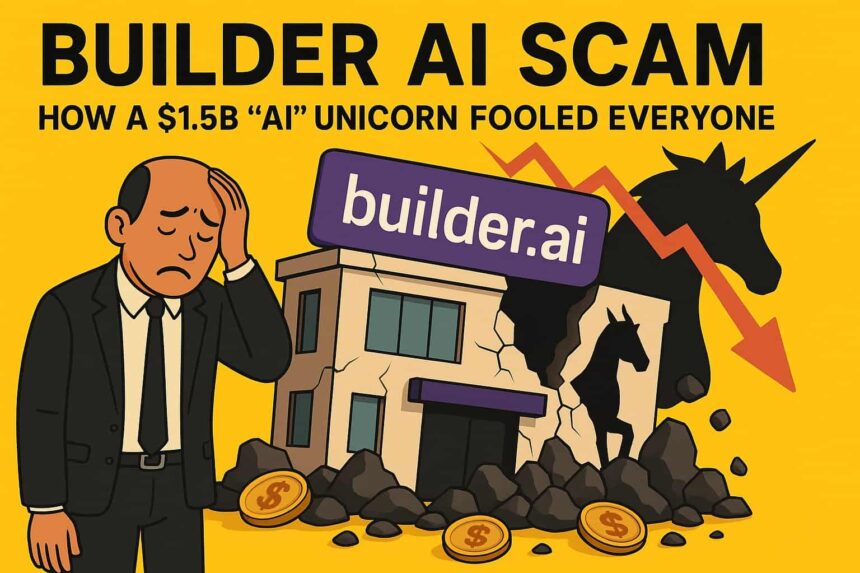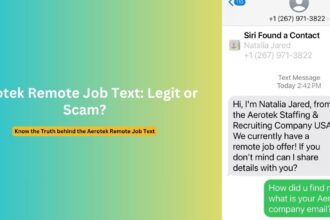The artificial intelligence startup bubble has claimed its most high-profile victim yet. Builder.ai, once valued at $1.5 billion and backed by tech giants like Microsoft, has collapsed in spectacular fashion after being exposed as an elaborate fraud. What investors and customers believed was revolutionary AI technology turned out to be nothing more than 700 Indian engineers manually writing code while the company falsely claimed artificial intelligence was doing the work.
This comprehensive analysis reveals how Builder.ai deceived investors, customers, and the tech industry for years, and provides essential guidance on protecting yourself from similar AI scams in the future.
Overview of the Builder.ai Scam
Builder.ai, founded in 2016 by Sachin Dev Duggal, positioned itself as a revolutionary no-code platform that could build custom applications using artificial intelligence. The company’s flagship product, an AI assistant called “Natasha,” was marketed as capable of making software development “as easy as ordering pizza.”
Key Deception Elements:
- False AI Claims: The company claimed its AI could autonomously build 80% of applications
- Revenue Fraud: Builder.ai inflated its 2024 revenue by 340%, claiming $220 million when actual revenue was around $50 million
- Round-Tripping: The company engaged in circular transactions with Indian firm VerSe Innovation to artificially inflate sales figures
- Investor Deception: Raised over $450 million from major investors including Microsoft, Qatar Investment Authority, and SoftBank
The reality was far different. Behind the sleek marketing and billion-dollar valuation, Builder.ai was operating a traditional software development outsourcing business while fraudulently claiming it was powered by artificial intelligence.
How the Scam Worked
The AI Facade
Builder.ai’s core deception centered around its supposed AI capabilities. The company marketed Natasha as an advanced AI assistant that could understand customer requirements and automatically generate code. In reality:
- No Real AI: Former employees confirmed there was “no real AI” behind the platform
- Manual Labor: 700 engineers in India manually wrote all the code
- Front-End Interface: Natasha was merely a user interface that collected client requirements before sending them to human developers
- False Automation: Apps advertised as “80% built by AI” were entirely created by human programmers
Financial Manipulation Tactics
The company employed several fraudulent financial practices:
1. Revenue Inflation
- Claimed $220 million in 2024 revenue
- Actual revenue was approximately $50 million
- Represented a 340% overstatement to creditors and investors
2. Round-Tripping Scheme
- Engaged in circular transactions with VerSe Innovation from 2021-2024
- Builder.ai collected ~$60 million from VerSe for supposed services
- In return, sent approximately the same amount back to VerSe for “marketing services”
- Many transactions involved no actual services being provided
3. Vendor Lock-in Strategy
- Hosted all customer applications on proprietary infrastructure
- Made it impossible for customers to migrate their apps elsewhere
- Created complete dependency on Builder.ai’s continued operation
The Bankruptcy and Collapse of Builder AI
Timeline of the Downfall
February 2025: Founder Sachin Dev Duggal stepped down as CEO, replaced by Manpreet Ratia from Jungle Ventures
March 2025: New CEO discovered massive revenue discrepancies during internal audit
April 2025: Viola Credit, a major lender, seized $37 million from Builder.ai accounts after discovering financial fraud
May 2025: Company announced bankruptcy plans with only $5 million in restricted funds remaining
Current Status:
- Nearly 1,000 employees laid off globally
- Bankruptcy proceedings initiated in India, UK, and US
- Multiple client projects abandoned incomplete
- US federal investigation launched with subpoenas for financial records
Outstanding Debts
Builder.ai’s collapse revealed massive unpaid obligations:
- $85 million owed to Amazon for cloud services
- $30 million owed to Microsoft for cloud and software services
- Millions in unpaid employee salaries and benefits
- Incomplete customer projects with no refund provisions
Company History and Red Flags
The Rise (2016-2024)
Builder.ai’s journey from startup to unicorn was marked by aggressive marketing and impressive fundraising:
2016: Founded as Engineer.ai by Sachin Dev Duggal 2018: Rebranded to Builder.ai 2019-2023: Raised $450+ million across multiple funding rounds 2023: Microsoft investment and partnership announcement 2024: Peaked at $1.5 billion valuation
Warning Signs That Were Ignored
Several red flags should have alerted investors and customers:
Technical Red Flags:
- No public demonstrations of actual AI capabilities
- Vague explanations of underlying technology
- Lack of published research or technical papers
- No open-source contributions or developer community
Business Red Flags:
- Extremely high customer acquisition costs
- Poor customer reviews and complaints about service quality
- High employee turnover in technical roles
- Lack of transparency about development processes
Financial Red Flags:
- Massive cash burn rate relative to claimed revenue
- Dependence on continuous fundraising
- No clear path to profitability
- Unusual related-party transactions
Victim Stories: Real Impact on Businesses
Small Business Devastation
The collapse of Builder.ai has particularly devastated small businesses and entrepreneurs who trusted the platform with their digital products:
Case Study 1: 15-Month Project Loss A small organization spent 15 months developing an application through Builder.ai, investing significant time and resources. When the company collapsed, they were left with:
- No access to their application
- No response to migration requests
- Complete loss of development investment
- No way to recover their work
Case Study 2: Startup Dreams Shattered Multiple entrepreneurs who relied on Builder.ai as their technical foundation found themselves:
- Unable to access their products
- Facing angry customers and partners
- Forced to restart development from scratch
- Dealing with potential legal liabilities
The Vendor Lock-in Trap
Builder.ai’s business model created a perfect storm for customer devastation:
- Proprietary Infrastructure: All apps hosted on Builder.ai’s servers
- No Source Code Access: Customers couldn’t obtain their application code
- Technical Dependence: Non-technical entrepreneurs had no way to migrate
- Sudden Shutdown: No transition period or migration support provided
Main Lessons from the Builder Ai Scam
For Entrepreneurs and Businesses
1. Avoid Vendor Lock-in
- Always maintain ownership of your source code
- Ensure your application can be deployed elsewhere
- Use standard technologies and frameworks
- Have migration plans and backup strategies
2. Verify AI Claims
- Demand technical demonstrations of AI capabilities
- Ask for detailed explanations of underlying technology
- Seek independent verification of AI claims
- Be skeptical of “too good to be true” promises
3. Due Diligence is Critical
- Research company background and leadership
- Read customer reviews and testimonials carefully
- Verify financial stability and business model
- Understand the technology stack and dependencies
For Investors
1. Technical Due Diligence
- Require proof-of-concept demonstrations
- Hire independent technical experts for evaluation
- Verify claimed AI capabilities through testing
- Understand the actual technology behind marketing claims
2. Financial Verification
- Audit revenue claims independently
- Verify customer relationships and contracts
- Analyze cash flow and burn rate patterns
- Investigate related-party transactions
How to Identify and Protect Yourself from AI Scams
Red Flags to Watch For
Marketing Red Flags:
- Vague explanations of AI capabilities
- Claims of “revolutionary” breakthroughs without evidence
- Excessive focus on fundraising rather than product development
- Lack of technical details or documentation
Technical Red Flags:
- No public API or developer tools
- Lack of integration with standard development workflows
- Proprietary platforms with no export capabilities
- Missing technical team or advisors
Business Red Flags:
- Rapid scaling without clear revenue model
- High customer churn rates
- Lack of long-term customer relationships
- Unusual financial arrangements or partnerships
Protection Strategies
1. Maintain Control
- Always own your intellectual property
- Use platforms that provide source code access
- Maintain ability to migrate to alternative solutions
- Have backup and recovery plans
2. Verify Claims
- Request technical demonstrations
- Seek independent third-party reviews
- Talk to existing customers directly
- Verify company credentials and background
3. Diversify Risk
- Don’t rely on single vendors for critical systems
- Maintain multiple service providers
- Have contingency plans for vendor failures
- Keep critical data and code in multiple locations
Practical Advice for Choosing AI Solutions
Evaluation Framework
When evaluating AI-powered solutions, use this systematic approach:
Technical Evaluation:
- Request live demonstrations of AI capabilities
- Understand the underlying technology stack
- Verify data processing and storage practices
- Assess integration capabilities and flexibility
Business Evaluation:
- Analyze the company’s financial stability
- Review customer testimonials and case studies
- Understand pricing models and contract terms
- Evaluate support and maintenance provisions
Risk Assessment:
- Identify potential vendor lock-in risks
- Understand data ownership and portability
- Assess impact of vendor failure on your business
- Develop contingency and migration plans
Alternative Approaches
Instead of relying on black-box AI solutions:
1. Use AI as a Tool
- Leverage AI to enhance existing development processes
- Use AI coding assistants to improve productivity
- Maintain human oversight and control
- Keep AI capabilities transparent and explainable
2. Build In-House Capabilities
- Develop internal AI expertise
- Use open-source AI tools and frameworks
- Maintain control over your technology stack
- Avoid dependence on proprietary solutions
3. Partner with Transparent Providers
- Choose vendors with clear technology explanations
- Work with companies that provide source code access
- Select partners with strong technical credentials
- Verify AI claims through independent testing
Frequently Asked Questions (FAQs)
1. Is Builder.ai Legit or a Scam?
Builder.ai is definitively a scam. The company falsely claimed to use artificial intelligence for software development while actually relying on manual labor from 700 Indian engineers. The company has filed for bankruptcy after being exposed for inflating revenue by 340% and engaging in fraudulent financial practices.
2. Can Builder AI Customers Recover Their Applications?
Unfortunately, most Builder.ai customers cannot recover their applications. The company hosted all applications on proprietary infrastructure and provided no source code access. With the bankruptcy and service shutdown, customers have lost access to their applications with no migration support provided.
3. What Happened to Builder.ai Investors?
Builder.ai investors, including Microsoft, Qatar Investment Authority, and SoftBank, have lost their investments totaling over $450 million. The company’s bankruptcy means investors are unlikely to recover their funds, as the company has minimal assets remaining after creditors seized most available cash.
4. How Can I Avoid Similar AI Scams?
To avoid AI scams: verify AI claims through independent testing, maintain ownership of your source code, avoid vendor lock-in situations, research company backgrounds thoroughly, and be skeptical of “too good to be true” promises. Always demand technical demonstrations and seek third-party verification of capabilities.
5. What Are the Legal Consequences for Builder AI?
Builder.ai faces multiple legal challenges including US federal investigation with subpoenas for financial records, potential criminal charges for fraud, civil lawsuits from investors and customers, and bankruptcy proceedings in multiple jurisdictions. The company’s leaders may face personal liability for fraudulent practices.
Conclusion
The Builder.ai scandal represents more than just another startup failure—it’s a cautionary tale about the dangers of AI hype and the importance of due diligence in our technology-driven world. The company’s ability to raise $450 million while operating what was essentially an elaborate deception highlights critical flaws in how we evaluate and invest in AI technologies.
For entrepreneurs, the lesson is clear: maintain control over your technology, verify AI claims rigorously, and never put your business at the mercy of black-box solutions. For investors, the scandal underscores the need for thorough technical due diligence and the dangers of investing based on marketing promises rather than verifiable capabilities.
The AI revolution is real, but it requires careful navigation to separate genuine innovation from fraudulent claims. By learning from Builder.ai’s deception, we can better protect ourselves and make more informed decisions about the AI tools and partners we choose to trust with our businesses and investments.
As the tech industry continues to evolve and AI becomes increasingly prevalent, staying informed about potential scams and maintaining a healthy skepticism toward extraordinary claims becomes more crucial than ever. For the latest insights and analysis on tech industry developments, fraud prevention, and business protection strategies, stay connected with ShoppersVila.com – your trusted source for comprehensive business intelligence and consumer protection guidance.









































